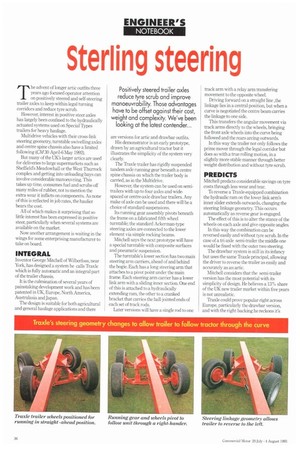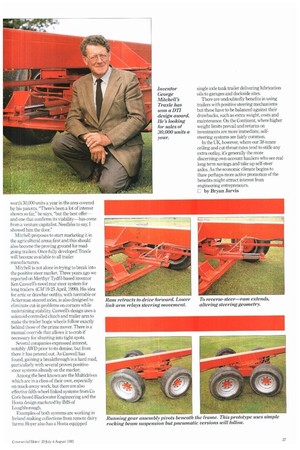Sterling steering
Page 28

Page 29

If you've noticed an error in this article please click here to report it so we can fix it.
The advent of longer artic outfits three years ago focused operator attention on positively steered and self-steering trailer axles to keep within legal turning corridors and reduce tyre scrub.
However, interest in positive steer axles has largely been confined to the hydraulically actuated systems used on Special Types trailers for heavy haulage.
Multidrive vehicles with their cross-link steering geometry, turntable swivelling axles and centre spine chassis also have a limited following (CM 30 April-6 May 1992).
But many of the UK's larger artics are used for deliveries to large supermarkets such as Sheffield's Meadowhall or the West Thurrock complex and getting into unloading bays can involve considerable manoeuvring. This takes up time, consumes fuel and scrubs off many miles of rubber, not to mention the extra wear it inflicts on components. As none of this is reflected in job rates, the haulier bears the cost.
All of which makes it surprising that so little interest has been expressed in positive steer, particularly when several systems are available on the market.
Now another arrangement is waiting in the wings for some enterprising manufacturer to take on board.
INTEGRAL
Inventor George Mitchell of Wilberfos.s, near York, has designed a system he calls Traxle which is fully automatic and an integral part of the trailer chassis.
It is the culmination of several years of painstaking development work and has been patented in UK, Europe, North America, Australasia and Japan.
The design is suitable for both agricultural and general haulage applications and there are versions for artic and drawbar outfits.
His demonstrator is an early prototype, drawn by an agricultural tractor but it illustrates the simplicity of the system very clearly.
The Traxle trailer has rigidly suspended tandem axle running gear beneath a centre spine chassis on which the trailer body is carried, as in the Multidrive.
However, the system can be used on semitrailers with up to four axles and wide spaced or centre-axle drawbar trailers. Any make of axle can be used and there will be a choice of standard suspensions.
Its running gear assembly pivots beneath the frame on a fabricated fifth wheel turntable; the standard Ackerman-type steering axles are connected to the lower element via simple rocking beams.
Mitchell says the next prototype will have a special turntable with composite surfaces and pneumatic suspension.
The turntable's lower section has two main steering arm carriers, ahead of and behind the bogie. Each has a long steering arm that attaches to a pivot point under the main frame. Each steering arm carrier has a lower link arm with a sliding inner section. One end of this is attached to a hydraulically extending ram, the other to a cranked bracket that carries the ball-jointed ends of each set of track rods.
Later versions will have a single rod to one track arm with a relay arm transfering movement to the opposite wheel.
Driving forward on a straight line ,the linkage lies in a central position, but when a curve is negotiated the centre beam carries the linkage to one side.
This transfers the angular movement via track arms directly to the wheels, bringing the front axle wheels into the curve being followed and the rears arcing outwards.
In this way the trailer not only follows the prime mover through the legal corridor but does so with a true rolling motion, in a slightly more stable manner through better weight distribution and without tyre scrub.
PREDICTS
Mitchell predicts considerable savings on tyre costs through less wear and tear.
To reverse a Traxle-equipped combination the hydraulic ram on the lower link arm's inner slider extends outwards, changing the steering linkage geometry. This occurs automatically as reverse gear is engaged.
The effect of this is to alter the stance of the wheels on each axle and give opposite angles.
In this way the combination can be reversed easily and without tyre scrub. In the case of a tri-axle semi-trailer the middle one would be fixed with the outer two steering.
The drawbar system is still in its infancy but uses the same Traxle principal, allowing the driver to reverse the trailer as easily and accurately as an artic.
Mitchell considers that the semi-trailer version has the most potential with its simplicity of design. He believes a 13% share of the UK new trailer market within five years is not unrealistic.
Traxle could prove popular right across Europe, particularly the drawbar version, and with the right backing he reckons it's worth 30,000 units a year in the area covered by his patents. "There's been a lot of interest shown so far," he says, "but the best offer-and one that confirms its viability—has come from a venture capitalist. Needless to say, I showed him the door."
Mitchell proposes to start marketing it in the agricultural arena first and this should also become the proving ground for roadgoing trailers. Once fully developed Traxle will become available to all trailer manufacturers.
Mitchell is not alone in trying to break into the positive steer market. Three years ago we reported on Merthyr Tydfil-based inventor Ken Caswell's novel rear steer system for long trailers (CM19-25 April, 1990). His idea for artic or drawbar outfits, with turntable or Ackerman steered axles, is also designed to eliminate cut-in problems on corners while maintaining stability. Caswell's design uses a solenoid-controlled clutch and trailer arm to make the trailer bogie wheels follow exactly behind those of the prime mover. There is a manual override that allows it to crab if necessary for shunting into tight spots.
Several companies expressed interest, notably AWD prior to its demise, but from there it has petered out. As Caswell has found, gaining a breakthrough is a hard road, particularly with several proven positivesteer systems already on the market.
Among the best known are the Multidrives which are in a class of their own, especially on muck-away work, but there are also effective fifth-wheel-linked systems from Co Cork-based Blackwater Engineering and the Hosta design marketed by IMS of Loughborough.
Examples of both systems are working in Ireland making collections from remote dairy farms; Hoyer also has a Flosta-equipped single axle tank trailer delivering lubrication oils to garages and dockside sites.
There are undoubtedly benefits in using trailers with positive steering mechanisms but these have to be balanced against their drawbacks, such as extra weight, costs and maintenance. On the Continent, where higher weight limits prevail and returns on investments are more immediate, selfsteering systems are fairly common.
In the UK, however, where our 38-tonne ceiling and cut-throat rates tend to stifle any extra outlay, it's generally the more discerning own-account hauliers who see real long term savings and take up self-steer axles. As the economic climate begins to thaw perhaps more active promotion of the benefits might attract interest from engineering entrepreneurs.
0 by Bryan Jarvis








































































